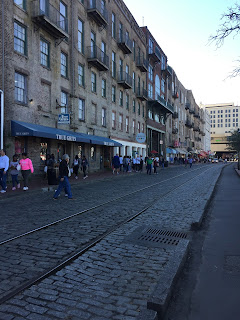Savannah and Charleston.
Old fashioned carriage rides are popular tourist attractions.
One can get fresh shrimp or
southern barbequed pork, not to mention their addictive sweet iced tea, in either place.
And
both of these tourist-driven cities have adopted this wonderful idea of free
shuttle buses around their historic areas.
Despite all their similarities, here are the differences:
1. Streets and parks
Charleston, South Carolina, does not have arrow-straight
streets nor parks all lined up in a row like Savannah. It is an older city and
was built on a peninsula, so the roads bend at will and the parks are placed
around the city along the waterfronts. It has far fewer parks, but what it has
are much larger.
2.
Waterfront
But it is well worth the danger to get to stroll
along the cobblestone road and enjoy the assortment of shops and restaurants.
Charleston has lost most of its cobblestone streets, except
this one preserved near the tip of the peninsula.
What it does have is a
pedestrian walkway made of slate slabs. This walkway borders the waterfront
street, but it is raised 4 feet above the street level, making it easy to
see both the harbour and the beautiful houses on the other side of the road
despite the heavy traffic.
3.
Architecture
Savannah streets were designed before the houses were built,
so the footprints of their homes are almost all the same. To build a bigger house, owners had to expand
upwards, creating tall, narrow buildings.
Charleston has large elegant homes built by wealthy
plantation owners and some of them take up to a full half of the length of a
block. Most of these houses have their own expansive walled gardens as well.
4.
Markets
I preferred
shopping at a specialty store in the shopping district instead. These are the
kind of souvenirs I prefer to bring home.
We stopped in Charleston primarily for the city market. It
starts at Market Hall and stretches for 4 blocks.
Inside the long shelter is a
wide assortment of booths selling local sweet grass baskets, jewelry, and
clothing.
5.
Residents
Panhandling is banned in Savannah but buskers are not, and
can be great fun.
The locals are tolerant of tourists, but are quite aggressive
in their driving, so stay out of their way!
Our first walk down Charleston streets had us stopped by an
older man in a wheelchair asking for “coins for a cup of coffee”. When hubby
started digging in his pocket, the request changed to “and maybe a Danish?”
In
all, I found these residents extremely polite, even the young ones, with their
“yes, sir” and “no, ma’am” attitudes. I’d love to import that.
6.
History
Both cities have an amazing history and we enjoyed walking
the older districts. In Savannah, there were so many placards and historical
markers that it took a long time to walk a city block. They keep their historic
district in a time capsule. It was perfect to begin with, so why change it. All
new development is relegated to the outside edges of the city.
Charleston’s history is one of change. They are still finding
parts of an old fort lost beneath the streets and buildings. They enjoy what they
have, but aren’t afraid of progress.
The biggest difference between the two? Now that we’ve seen
Savannah, we probably won’t go back, unless it’s to buy more honey. But
Charleston with its changes, we may see again.
W










No comments:
Post a Comment